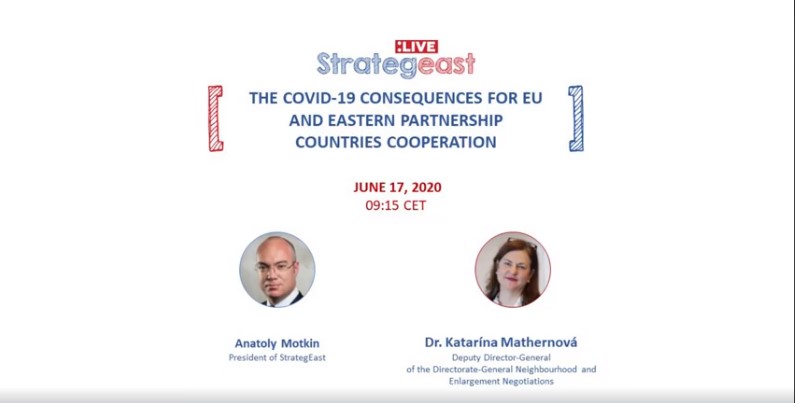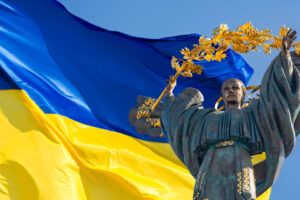The COVID-19 consequences for EU and Eastern Partnership countries cooperation
Dr. Katarína Mathernová, European Commission, Deputy Director-General of the Directorate-General Neighbourhood and Enlargement Negotiations interviewed by StrategEast Founder and President Anatoly Motkin
A.M.: From your perspective, is there any correlation between the nature of the regime of Eastern Partnership countries and their ability to combat the pandemic? I mean is there any difference distinguishing between more authoritarian and more liberal countries in their ability to cope with the pandemic.
K.M.: Well, I think I wouldn’t necessarily draw or mention these consequences naturally only for Eastern Partnership. We can see worldwide that different regimes reacted differently to COVID, and, you know, some democracies fared better, some more autocratic regimes fared better. So I would not necessarily say that that would be the sole distinguishing feature between who fares better and who doesn’t fare better in Eastern Partnership. What the world experience shows us is that more populist regimes or regimes with more populist leaders tend to not do that well in the pandemic. But there are so many variables, including previous experiences with the pandemics, etc., so I would stop at that.
A.M.: Belarus was the only Eastern Partnership country that had not introduced strict quarantine restrictions. How do you judge the results of this experience? Would it have any consequences for EU and Belarus relations?
K.M.: I don’t think it has consequences for EU-Belarus relations. I’m not sure that the word experiment is the one I would use in describing it. Plus, it’s not the end of the crisis. I would reserve my right to judge once we have the final figures, once we have the vaccine, and we can then judge what has happened throughout the period.
A.M.: According to the announcement of the European Commission, the EU will provide 80 million euros for immediate and 883 million euros for medium-term support to the six Eastern Partnership countries in response to the COVID-19 outbreak. We understand what is the purpose of the immediate assistance, but what the EU medium-term support is allocated for?
K.M.: There were three areas of intervention. One was the immediate humanitarian supply of personal protective equipment, etc. The second area is support to the health systems and also institutionally. Helping health systems is a medium-term measure that helps to strengthen them. The third area is support for the economy. That’s support for the liquidity provision to the enterprises facing liquidity constraints, etc. A lot of it concentrates on SME but also meets cab companies and individual entrepreneurs.
A.M.: If we move from medium-term to a long-term perspective. The economic consequences of the pandemic in the Eastern Partnership countries will have to be overcome for several years. All countries of the Eastern Partnership caught the pandemic during the period of rapid economic growth, and now economies are thrown back years ago. What recommendations can the European Union provide to the governments of the Eastern Partnership countries to return to rapid economic growth?
K.M.: I think it needs to continue with the reform path and with structural reforms for the economies, opening up the economies to get it into proper functioning. Plus, to use the stimulus that we are helping provide to restart the economy and get into a growth path. We will continue programming a very significant part of our assistance in subsequent years to help precisely with the restarting of the economies.
A.M.: The last crisis has demonstrated once again how vulnerable are the companies or the countries which are based on a single supplier. Once China at this time has locked its borders, many companies got to an easy situation cut off their supply chain. Don’t you think it might be a good reason to consider relocating European companies’ production from China to Eastern Partnership countries? Where the salaries are competitive and they are much closer to the EU border.
K.M.: There are going to be a number of consequences from this crisis, including realignment in world trade flows. We are seeing very clearly that the decoupling between the US and China is reality, and I think that there will be movements by a number of companies to onshore or nearshore as opposed offshoring to faraway places. If the Eastern Partnership countries positioned themselves well, they could be the beneficiaries. But that would mean having a very favorable investment climate, having predictability in the rule of law and in the overall environment. Then they can benefit from the trends that are likely to happen as you mentioned in bringing production closer to Europe.
A.M.: During the pandemic, the economies of the Eastern Partnership countries made a huge leap in the process of digital transformation. Much of what was planned to be done in the coming years, was done in just two months. What is the perspective of the single digital market program and its integration with Eastern Partnership countries in this regard? Perhaps its goals will require adjustment?
K.M.: The digital leap is a global phenomenon. Our colleagues who are looking after the digital single market have a very busy period now. I think there will be opportunities for closer integration in this area. I mean that we are building the digital single market, we don’t have it yet. But it is certainly an area where I see closer cooperation towards integration with the Eastern Partnership countries.
A.M.: Now when we look at the political system in Eastern Partnership countries, it’s an election cycle this year in some of them like Belarus, Georgia, and others. Some of them already discussed that there will be some restrictions because of the coronavirus, or maybe the elections would be moved to another date. Some opposition parties doubt that it’s actually not an excuse or maybe only an excuse. It’s not an easy time, hectic time, and there is some measure of understanding that we should get in our approach. How do you think to what degree the local governments could use this coronavirus, or corona crisis, for their internal political purposes?
K.M.: I’m sure that the temptation is there, and all the more reasons for all the institutions, all the various groups, and civil society citizens to be vigilant. To make sure that it does not happen. We can globally see that the temptation is there to use the crisis. However, as the infections get under control, as the situation normalizes issues, also should the political system adjust to that.
A.M.: The last question is about the Eastern Partnership Summit. What has changed in its agenda as a result of the pandemic, and what are the key deliverables to be achieved within the Summit?
K.M.: We are not going to the Summit as such this week. What we are going to have is the leaders’ video conference. The actual Summit has been agreed to be held in the first part of the next year under the Portuguese presidency. Not to replace a really unique possibility for a physical rendezvous just with the video conference. So we don’t call this a Summit, it’s leaders video conference that will be followed by a proper Summit declaration, etc. The Summit will be held in the winter-spring timing of 2021.
The leaders’ meeting over video this week will bring tree things. One, it will talk about the COVID response that the EU has done, and I think it showed very quickly solidarity with the Eastern Partnership countries and many others around. Second, it’s going to recognize the communication on Eastern Partnership, which went a little bit unnoticed. The reason is that it was the beginning of the crisis, and it was, in fact, adopted at the first-ever virtual meeting of the College of Commissioners in the beginning of March.
That is the communication that talks about the overall narrative of resilience that we want to help achieve within our six Eastern partners. It has five big areas of action for the future, including digital that we just discussed. It’s going to task the Commission with coming up with concrete deliverables that can be then indoors when it would be a proper summit in 2021. Just like we had 20 deliverables for 2020. We want to have a roadmap of very practical and pragmatic goals also for the future, and we will be busily developing that in consultation with the partner countries before the summit of next year.




